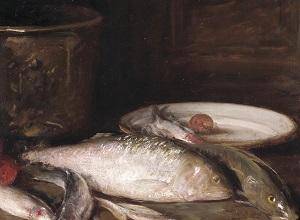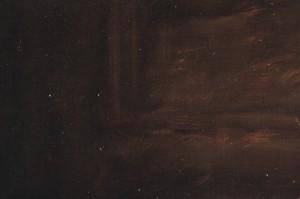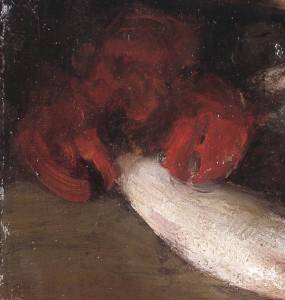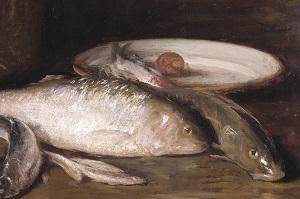William Merritt Chase’s painting Still Life with Fish provides students with the opportunity to discover beauty in unusual places and express their ideas through poetry.
Students will be able to:
- participate in a class discussion to analyze a painting;
- read and analyze poetry;
- write an original poem;
- recognize beauty in unusual places; and
- share their original work with the class.
Lesson
- Warm-up: Ask the students what they know about still life painting. When they think of still lifes, what subjects do they imagine? What items do they see most often in still life paintings?
- Show the class Chase’s painting Still Life with Fish. Is this a subject that comes to mind when they think of still life paintings? Lead a discussion about the painting, raising questions such as: What are the qualities that make this painting unique? How does Chase depict an unusual subject as beautiful? Is this painting beautiful?
- Using the About the Art section, explain to the students that Chase enjoyed turning the mundane into pleasing images. As Chase said, “Paint the commonplace in such a way as to make it distinguished.” To Chase, fish were objects of great beauty and he painted them frequently. Share with students the following statement by Chase: “I enjoy painting fishes; in the infinite variety of these creatures, the subtle and exquisite colored tones of the flesh, fresh from the water, the way their surfaces reflect the light, I take the greatest pleasure…It may be that I will be remembered as a painter of fish.”
- Introduce the two poems, Between Walls by William Carlos Williams and You Can’t Write a Poem About McDonald’s by Robert Wallace, to the class. Analyze the poems for the theme they share with the painting: namely, discovering beauty in unique places.
- Provide students with writing materials and allow them time to write a poem about how, when, and where they find beauty in unexpected places, people, or situations. The Types of Poetry website describes numerous poetry types.
Materials
- Pencils and paper or computers for writing two poems
- Internet access to information about different types of poetry like Types of Poetry from Shadow Poetry
- About the Art section on Still Life with Fish
- One color copy of the painting for every four children, or the ability to project the image onto a wall or screen
- Internet access or printed copies of the following poems: Between Walls by William Carlos Williams and You Can’t Write a Poem About McDonald’s by Robert Wallace
Standards
- Visual Arts
- Invent and Discover to Create
- Observe and Learn to Comprehend
- Relate and Connect to Transfer
- Envision and Critique to Reflect
- Language Arts
- Oral Expression and Listening
- Research and Reasoning
- Writing and Composition
- Reading for All Purposes
- Critical Thinking & Reasoning
- Information Literacy
- Invention
- Self-Direction
Still Life with Fish
- William Merritt Chase, American, 1849-1916
- Born: New York
- Work Locations: New York
William Merritt Chase was born in Williamsburg, Indiana, and began his formal art training in New York before heading to Germany, where he studied at the Munich Royal Academy for six years. While Chase identified himself as a realist, painting realistic still-lifes and portraits, others classified him as one of America’s best artists painting in an impressionistic style. His body of work spans a wide range of subject matter: still-lifes, portraits, landscapes, and impressionistic views. He always championed skillful technique over distinguished subject matter, and delighted in turning humble or inelegant common objects into pleasing images. In Chase’s words, “If you can paint a pot, you can paint an angel.”
Chase taught for over 38 years and was very proud of his role as a teacher. His teaching career included the Art Students League in New York and his own outdoor art school on Long Island. Chase would tell his students, “Be in an absorbent frame of mind. Take the best from everything.” One of his well-known students, Georgia O’Keeffe, once described him: “There was something fresh and energetic about him that made him fun…To interest him, paintings had to be alive with paint and a kind of dash and go.” Even though he received recognition and honors throughout his career, Chase relied on teaching to support his family and to give him the financial stability to avoiding painting works for the mere sake of marketability. Chase died at the age of 66 after several months of illness.
William Merritt Chase enjoyed turning mundane subjects into pleasing images. As he said, “Paint the commonplace in such a way as to make it distinguished.” Because fish were objects of great beauty to Chase, he painted them frequently. In 1913, he remarked, “I enjoy painting fishes; in the infinite variety of these creatures, the subtle and exquisite colored tones of the flesh, fresh from the water, the way their surfaces reflect the light, I take the greatest pleasure…It may be that I will be remembered as a painter of fish.” Chase’s impressive technique drew attention and acclaim to his work, placing his still lifes with fish in high demand. His affinity for a dark palette and bold brushwork were influenced by his studies at the Munich Royal Academy.
Chase was notorious for painting quickly. His dashing painting demonstrations, in which he completed a major composition within a few hours, were legendary. A fish painting like ours usually took him less than a day to complete. He would douse the fish he used as models in ice water to keep them from smelling. Story has it that Chase once rented a fish in order to paint it and returned it still fresh enough to be sold.
Details

Related Elements
One scholar refers to this painting as a “kitchen piece” because of its lack of “elegance,” its association with daily life, and because the elements depicted are related to the preparation of a meal. The fish is displayed with objects that might be used to prepare it.

Fish Paired With Pot
Chase enjoyed painting copper pots, so his choice of including one in the composition was not only practical but also aesthetic. The pot creates a play of color and shine between its burnished gold and the shimmering silver fish, and also a play of texture between the slithering fish and the firm structure of the pot.

Signs of Speed
Chase was able to achieve a strong sense of realism without a high degree of detail. In this work there are several examples of his quick vigorous brushwork. Chase creates a convincing fin by simply dragging a flat, dry brush through wet paint. There are several spots on the copper pot where the canvas is still visible.

Dark Background
Chase admired many 17th century Dutch artists and hung copies of their paintings in his studio. By recreating the characteristic dark background used by these artists, Chase was able to better highlight the light silvery tones of his fish.

Color
Chase used color carefully in this painting to create a rich, warm atmosphere. The golden-brown foreground and background accentuate the silvery-grey fish, while the bright red of the lobster and onion balance and enliven the composition.

Repeated Curves
A group of dead fish gave Chase an opportunity to compose an elegant series of related curves. And by including the cooking pot and white plate, he could take the echoing shapes a step further.
Funding for object education resources provided by a grant from the Morgridge Family Foundation. Additional funding provided by the William Randolph Hearst Endowment for Education Programs, and Xcel Energy Foundation. We thank our colleagues at the University of Denver Morgridge College of Education.
The images on this page are intended for classroom use only and may not be reproduced for other reasons without the permission of the Denver Art Museum. This object may not currently be on display at the museum.






